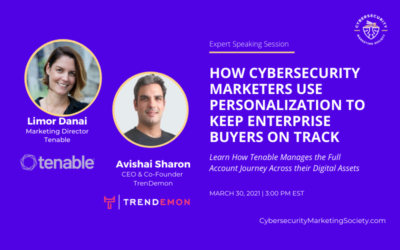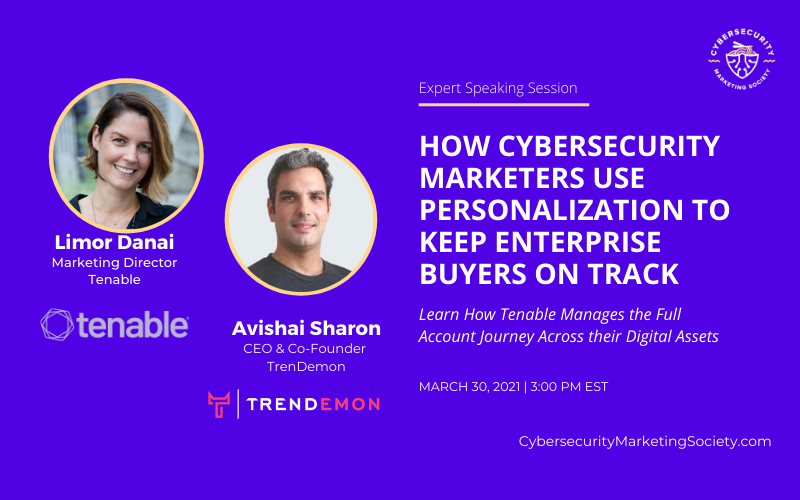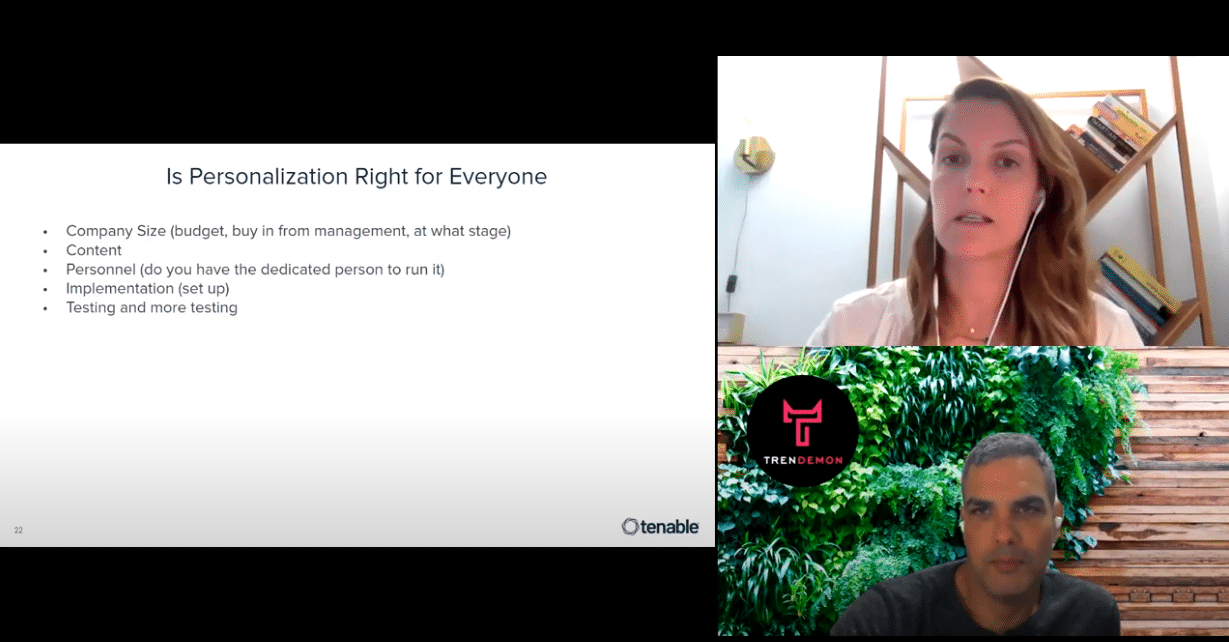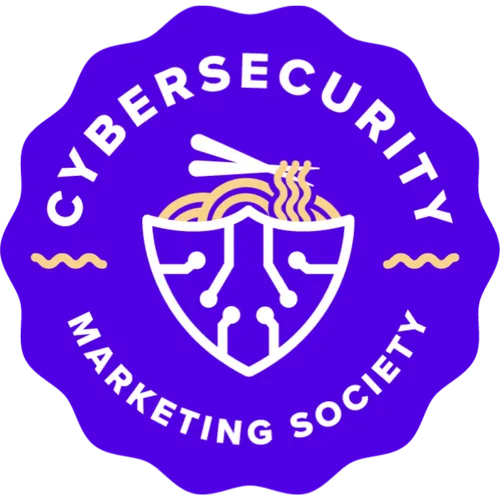How Cyber Marketers Use Personalization to Keep Enterprise Buyers on Track



You’ve broken through the cybersecurity marketing noise. You have an engaged prospect on your site — now, how do you keep them engaged and progressing through a persona-based customer journey via content?
On March 30, Limor Danai, Marketing Director of Tenable, and Avishai Sharon, CEO of Trendemon, shared how Tenable builds effective, ROI-positive content that progresses buyers along the content journey.
They also explored best practices, shared unique data about the B2B buying journey and how to build scalable, ABM compatible and adaptive website experiences that help engage the relevant personas.
What Do Personalization Companies Do? About Trendemon
Trendemon is an attribution-based personalization platform focusing on b2b cybersecurity companies. Most companies have CRM, marketing automation, CMS, analytics, but Trendemon fills the gap between incoming traffic and becoming a lead. Trendemon:
- 1) maps customer journeys to goals in marketing automation and CRM
- 2) measures the impact of your assets and channels on business outcomes, and
- 3) serves relevant content and messages on your site to the relevant audiences.
Sharon noted how most companies only see the tip of the iceberg — they don’t see the buyer’s activities, such as LinkedIn activity, remarketing PPC, and ABM campaigns, before conversion and signup. They might only see buyers coming from Google.
About Tenable
Tenable is a cyber exposure company that helps companies reduce their cybersecurity risk. It has an array of products, each of which is targeted to a different buyer persona with different sales cycles, needs, and markets. The company builds a personalized customer journey for each persona.
What Data You Need for Personalization
Danai discussed the different levels of personalization:
- Geography and language: the most broad level
- When/where: page visits and read time
- Account/industry
- Attribution and what they are consuming
When you combine these levels, you get the ultimate personalization, reducing the friction in the buyer’s journey.
There are many different tools that Tenable uses to orchestrate data for personalization and address buyers’ interests:
- CRM feeds into sales and gets intent data
- Content consumption tool
- Personalization tool: CTAs, analytics, intent
- Marketing automation provides data on the lead lifecycle status, email marketing / nurture
- Conversational tool
- ABM tool: intent data
- Digital campaigns: retargeting, ABM, paid social
All these tools need to work together to deliver a streamlined personalization campaign. Although not every company will have this tech stack, they can still leverage the tools they have.
Should Your Company Implement Personalization Campaigns?
Danai believes that everyone can deploy personalization, but each company needs to consider these factors:
- Company Size: How much is your budget? Do you have buy-in from management? What stage is your company in?
- Content: Because COVID canceled in-person conferences, everyone is online and is consuming a lot of information. Companies need a mix of content to keep people on the website, and they also need enough content to last through the different stages of the buyer journey.
- Personnel: Do you have a dedicated person to run personalization campaigns? This person should be skilled in analytics. The title matters less than the knowledge of this person.
- Implementation and Set Up: Companies need to ensure they set up their back-end processes, like making sure their landing pages are ready.
- Testing: Companies need to track what’s working to see what to improve and consistently analyze how they can iterate. This is why there needs to be a dedicated person to run these campaigns.
Marketing and sales need to work together to see how personalization might be able to impact pipeline and quality of leads. Danai said, “ To show the intent: what the buyers are interested in, are doing on the website, and what they’re interested in — providing this info directly to sales is of great value to them.”

Does ACV influence how personalization is implemented?
In response to a viewer question on if ACV should be considered, Sharon noted that large ACV products with multiple people and long journeys will have longer sales cycles. There needs to be many more touchpoints for engagement. Consumer products are more transactional, and personalization may be less content and more offerings (think Amazon). Companies need to determine if they’re personalizing the messaging, the flow, or the product.
How to Build Content for Personalization
Sharon emphasized the difference between guiding and gating. With guiding, you get people to your site, capture the lead, and chase them to sales development. Gating is a little more difficult because 78% of Gen Xers to millennials won’t fill a form to get information. Marketing still needs to deliver leads, but leads can’t be premature. There is that eternal tension – when do you want to pop the question and ask them to sign up?
Sharon shared Trendemon’s findings on the stages of the B2B journey:
- External Exposure and Research: This stage establishes trust. 35% of B2B journeys happen from external exposure and research.
- Education: This stage establishes expertise of the company. 45% of the journey is anonymous research on the company’s website.
- Engagement: This stage establishes need. 20% of the journey is known contact, such as when a person fills in a form.
Companies need to be proactive in the second stage because 45% of the journey is anonymous research — management needs buy-in because these deals for enterprise buyers will continue or not continue here.
This journey also impacts if you’re guiding or gating. Danai said that gating content depends on where leads are in the journey and what content they have access to. Gating content to get a lead makes sense when they’re going to the end of the journey. Whitepapers are the highest converting pieces. On the other hand, ungated content is for awareness and education.
Sharon also found that the best CTR forms have 1 field: “If you don’t have to capture multiple fields, don’t.” But again, Danai highlighted that you need to balance the needs of marketing and sales. Marketing wants the lead to meet their quotas, but sales needs more data to follow up and continue the conversation for conversion. She said, “Not always are our interests aligned.”
Sharon also added, “If you’re a smaller organization, if you have the ability to reduce those thresholds, don’t put more hurdles between your users and your content than is necessary.”
How Many Personalization Campaigns Should You Have?
Danai had 3 running personalization campaigns when she first joined Tenable, and she now has 20+ running at the same time. You need buy-in from the company to see it’s working and, once you do, you’ll get more requests. She noticed that there’s plenty of demand for geographical personalization. However, “you don’t want to annoy your visitors on the website” with tons of pop-ups and distractions. Therefore, you can’t have too many (well-designed) campaigns;you should prioritize what’s working well for your website.
Sharon shared from Trendemon’s research that the most successful companies (companies with the highest CTR or click-through rate) run 10+ more personalization campaigns on their websites. He said, “The more contextual conversations you can have, the better the engagement is. The highest CTR campaigns have double triggers (scroll and exit time). Content hubs reach double digit CTRs. Surveys are great to find target personas and are highly engaging.”
Learning More About Personalization
If you want to learn more about how your company can drive engagement throughout a customer journey, you can watch the full session here.Follow the Cybersecurity Marketing Society on LinkedIn and Twitter to join more events like this.

.png)
.png)
.png)